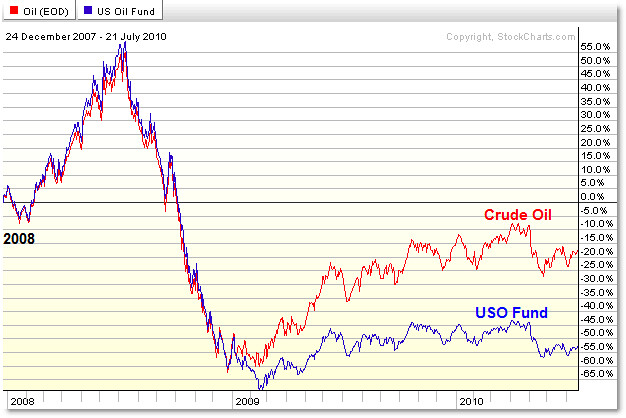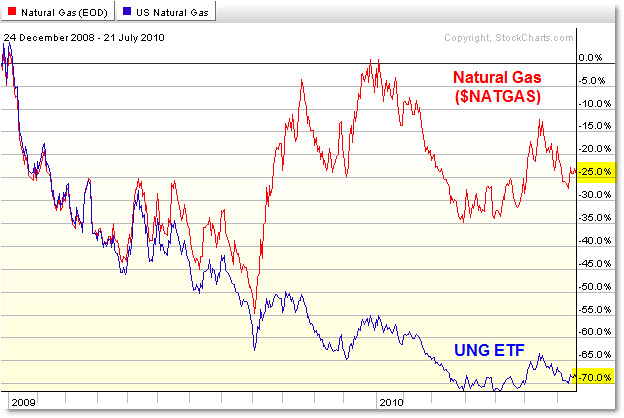RE: bloomberg story on rigged ETFsInteresting that when I went looking for this news article, it had been moved or removed. I found this though which highlights the original news link posted by rdwww:
Bloomberg published a critical report for anyone who has ever purchased a commodity ETF – especially the USO (Crude Oil) and UNG (Natural Gas).
The article defines contango, shares real (shocking) experiences, and explains why these funds are not ideal for long-term investing due to the roll-over effect of commodity futures.
The article – a MUST read – is entitled:
“ETFs Imperil Investors When Contango Conspires with Pre-Rolling.”
[UPDATE: Article link is to the Disciplined Investor.com, who has a similar discussion as I have here - the original Bloomberg article is moved or removed]
I wanted to highlight a few of the most important quotes from the article:
The article begins with a typical investor seeing the plunge in oil prices to the $35 level in early 2009, so the investor calls his broker to buy shares of the crude oil fund USO – after all, the average long-term investor does not buy futures contracts.
His broker did so, but as crude rose exactly as expected, the USO investment underperformed:
“What happened next didn’t make sense. Wolf watched oil go up as predicted, yet USO kept going down. In February 2009, for example, crude rose 7.4 percent while USO fell 7.4 percent. What was going on?”
So the investor took to the blog world, and discovered other investors in the same angry predicament he was – and they were using the term “Contango.”
So he called two brokers, neither of which could define the term “Contango” for him – which added to his frustration.
From the article:
“Contango is a word traders use to describe a specific market condition, when contracts for future delivery of a commodity are more expensive than near-term contracts for the same stuff. It is common in commodity markets, though as Wolf and other investors learned, it can spell doom for commodity ETFs.
When the futures contracts that commodity funds own are about to expire, fund managers have to sell them and buy new ones; otherwise they would have to take delivery of billions of dollars’ worth of raw materials. When they buy the more expensive contracts — more expensive thanks to contango — they lose money for their investors. Contango eats a fund’s seed corn, chewing away its value.”
I strongly encourage you read the full article – it’s lengthy but essential for those who have been hurt by these commodity ETFs long term.
In fact, I wanted to show comparison charts in USO and UNG to their underlying index as seen in StockCharts.com.
First, Crude Oil and the USO percentage performance from 2008 to present:

The USO Fund tracked the performance of crude oil well through 2008, but contango affected the price in terms of monthly roll-over, which eroded the value of USO over time.
From 2008 to present, crude oil is down 20% while the USO Fund is down 55%. Unfortunately, the disconnect began right when many investors bought this fund – there is a huge volume spike during early 2009 (not shown).
Finally, the big discrepancy is between Natural Gas and the UNG Fund:

Like USO, the UNG Natural Gas ETF tracked the performance of underlying Natural Gas futures well… until early 2009, but the big dislocation was September 2009, and from that single month, the UNG has grossly underperformed the futures.
From 2009 to present, Natural Gas futures are down about 25% while the UNG ETF is down 70%.
It’s not that the funds are evil or bad, it’s just that they suffer from the effects of contango when ETF fund managers roll-over the holdings to the next futures month, which is priced higher than the current month – hence contango.
Swing traders and intraday traders still use these funds for quick positions, but long-term investors should read the prospectus very carefully and compare price charts of the past before investing for the long-haul in these and other commodity ETFs when contango exists.